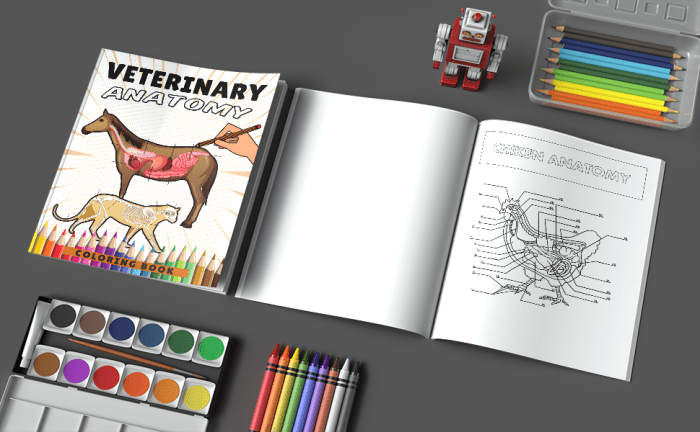Target Audience Analysis: Animal Antomy Coloring Book

Animal antomy coloring book – A gentle sigh escapes, a whisper of faded crayons and half-finished drawings, a melancholic reflection on the fleeting nature of childhood wonder. This coloring book, a quiet sanctuary of anatomical detail, seeks to capture the hearts and minds of a specific audience, a group whose curiosity blossoms amidst the intricate lines and vibrant hues.The delicate balance between engagement and educational value requires a careful consideration of the intended users.
Understanding their age, skills, and interests is crucial to crafting a book that resonates deeply and sparks a genuine appreciation for the natural world.
Age Range and Skill Level
The primary target audience for an animal anatomy coloring book spans a broad range, encompassing children aged 6 to 12 years old. This age group possesses a developing understanding of the world around them, coupled with a keen interest in both art and science. The coloring book assumes a beginner to intermediate skill level in coloring and drawing.
Simpler anatomical structures are presented initially, gradually increasing in complexity to challenge and engage the users as they progress. Younger children might focus on basic coloring, while older children could attempt more intricate shading and detail work.
Interests and Learning Styles
Children within this age group often exhibit a strong fascination with animals, often coupled with a thirst for knowledge. Their learning styles are diverse, encompassing visual, kinesthetic, and auditory learners. The coloring book aims to cater to these varied styles by presenting clear, visually appealing anatomical illustrations that can be colored and enhanced. The act of coloring itself is a kinesthetic activity, reinforcing learning through active participation.
A detailed explanation of animal anatomy, accompanying the illustrations, helps engage auditory and visual learners simultaneously.
User Persona: Lily, Animal antomy coloring book
Imagine Lily, an eight-year-old girl with bright, curious eyes. She loves animals, particularly cats and dogs. She enjoys drawing and coloring, often filling her notebooks with fantastical creatures and vibrant landscapes. Lily is a visual learner, absorbing information best through images and diagrams. She prefers hands-on activities and enjoys learning through exploration and play.
She’s a budding artist, but her coloring skills are still developing, making her the ideal representative of the target audience for this coloring book – a blend of artistic aspiration and scientific curiosity, a perfect union of creativity and knowledge. Lily’s quiet fascination with the inner workings of the animal kingdom is the very essence of this project’s purpose.
The book aims to capture that quiet wonder and nurture it.
Page Layout and Design

A single page, a canvas of bone and sinew, a whispered promise of life rendered in gentle hues. Each creature, a poem etched in line and color, demands a layout both reverent and practical, a balance between anatomical accuracy and the joy of creative expression. The design must serve as a guide, a gentle hand leading the colorist through the intricacies of form.The ideal layout prioritizes clarity and engagement.
Overcrowding dulls the senses, while stark emptiness leaves the heart unmoved. A delicate dance between detail and breathing room is key, allowing the beauty of the animal’s structure to unfold naturally.
Page Layout Options
Several approaches can be considered when arranging the anatomical illustrations. A single animal, sprawling across the page, offers a grand, immersive experience. Imagine a majestic whale, its skeletal frame delicately traced, inviting the colorist to fill in the rich blues and greys of the ocean’s depths. Alternatively, several smaller animals, perhaps a family of rodents or a flock of birds, could be arranged in a pleasing composition, creating a dynamic and engaging page.
This approach provides variety and allows for a greater range of species within the book. The choice should depend on the complexity of the animal’s anatomy and the overall aesthetic desired.
Use of Visual Cues
Precise anatomical labels and clear directional arrows are crucial for both educational accuracy and artistic success. Imagine a delicate arrow pointing to the intricate network of capillaries in a hummingbird’s wing, or a carefully placed label identifying the subtle curvature of a feline’s spine. These cues act as a bridge, connecting the visual representation to the underlying scientific knowledge, guiding the colorist while enriching their understanding.
They are not mere additions but integral components of the design, enhancing the overall learning experience.
Sample Page Layout
Consider the following table structure as an example of a possible page layout. This example demonstrates the arrangement of labels and anatomical structures for a single animal, a graceful deer.
| Anatomical Structure | Label Placement | Color Suggestion |
|---|---|---|
| Antlers | Above the antlers, slightly offset | Warm browns, hints of gold |
| Spine | Following the spine’s curvature | Subtle variations of beige and brown |
| Rib Cage | Within the rib cage, lightly tracing each rib | Pale ivory, subtle shading |
| Leg Muscles | Near the major muscle groups | Deep reds, maroons, and subtle purples |
| Hooves | Beneath the hooves | Dark browns, almost black |
The table provides a structured framework, offering a guide for both the artist creating the illustration and the user engaging with the coloring book. The careful placement of labels ensures that the anatomical details are clearly identified without disrupting the overall aesthetic of the artwork. The color suggestions serve as inspiration, inviting the user to explore the spectrum of natural hues.
This table structure is just one example, and different animals will naturally require variations to accommodate their unique anatomical features.
Dissecting the intricate details of an animal anatomy coloring book, one finds a strangely satisfying precision. The meticulous rendering of muscle groups and bone structures oddly mirrors the intense focus required for, say, the vibrant detail in popular anime coloring pages. Both, in their own way, demand a patient hand and a keen eye for the unseen, transforming blank pages into living, breathing representations of form.
